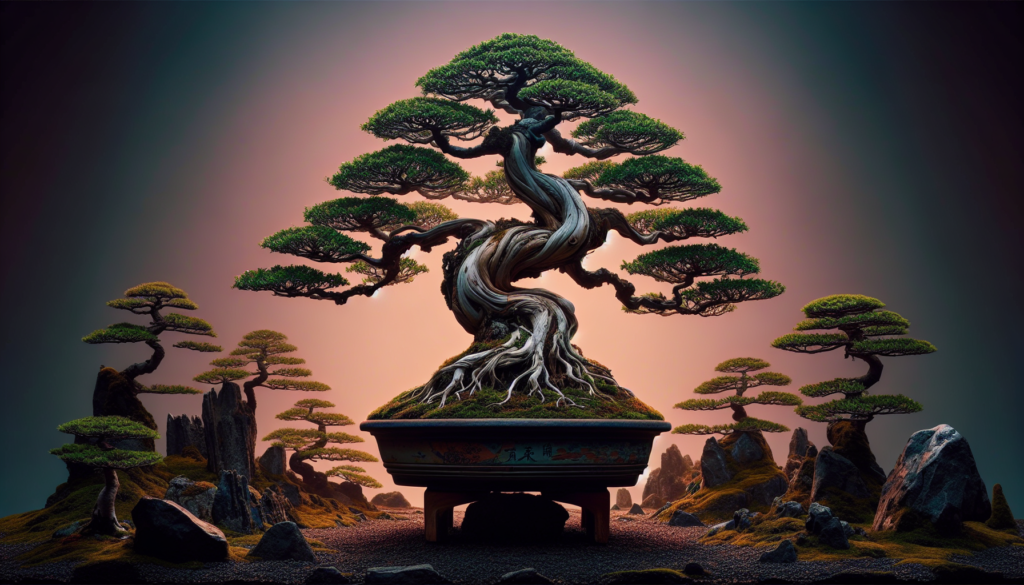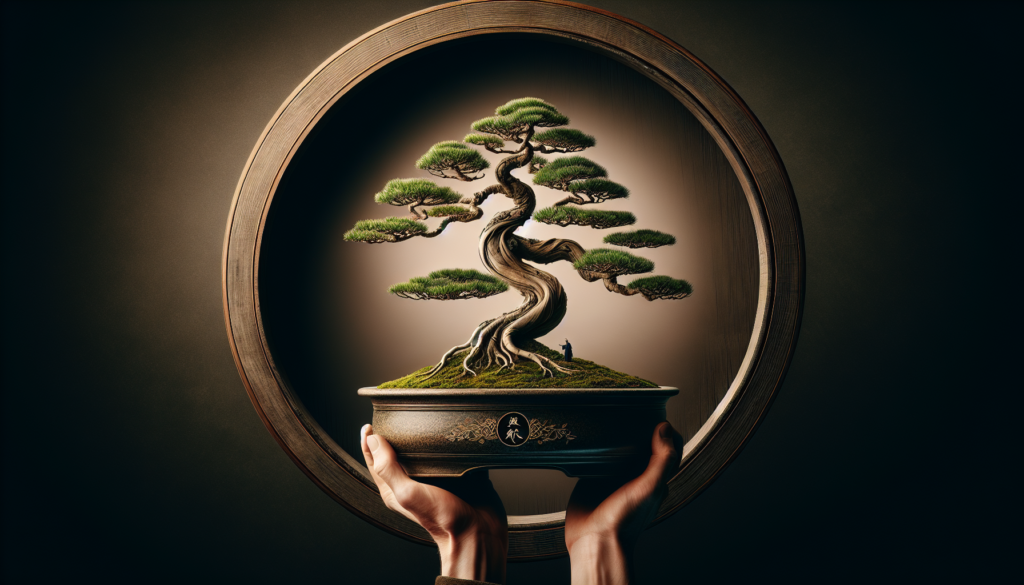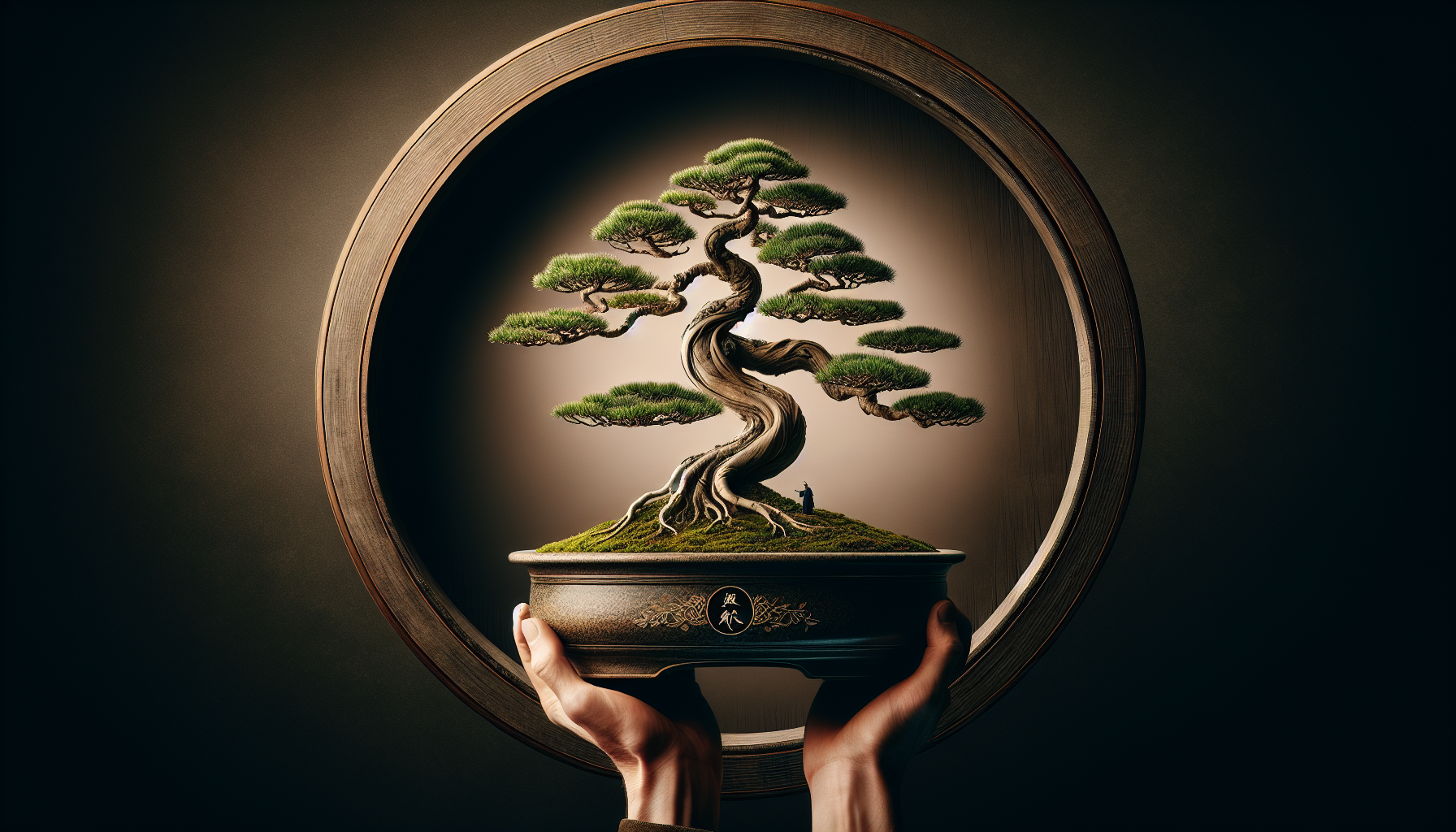Imagine stepping into a serene garden, surrounded by miniature trees carefully crafted to resemble their full-size counterparts. In the world of Japanese culture, this is the captivating art of bonsai. With its roots dating back centuries, bonsai has become an integral part of Japanese culture, influencing not only the way people appreciate nature but also their philosophy and way of life. From its humble beginnings to its modern-day popularity, the rich influence of bonsai in Japanese culture is a testament to the enduring beauty and time-honored traditions that continue to captivate enthusiasts around the globe.

Origins of Bonsai Art
The art of bonsai has a long and fascinating history that dates back centuries. Although it is commonly associated with Japan, bonsai actually originated in ancient China. The practice of growing and shaping miniature trees in pots was introduced to Japan in the 6th century, when Buddhism was first introduced to the island nation. Japanese monks brought back bonsai trees from their travels to China, and this marked the beginning of the art form in Japan.
Significance of Bonsai Art in Ancient Japan
Bonsai quickly became a cherished art form in ancient Japan. It was not only regarded as a visual art, but it also held great symbolic and spiritual significance. Bonsai was seen as a reflection of the beauty of nature and the impermanence of life. It was also believed to bring good fortune and luck to those who cultivated and cared for the miniature trees. The meticulous cultivation and maintenance of bonsai trees required discipline and patience, making it a popular practice among Japanese nobility and samurai warriors.
Evolution of Bonsai from China to Japan
While bonsai initially arrived in Japan from China, it quickly evolved and developed its own unique style in Japan. Influenced by the Japanese aesthetic principles of simplicity, asymmetry, and naturalness, bonsai in Japan took on a more delicate and refined appearance. Japanese bonsai artists began to experiment with different styles and techniques, creating miniature trees that represented natural landscapes and evoked a sense of tranquility and harmony. This shift in style marked the emergence of Japanese bonsai as a distinct art form.
Aspects of Japanese Culture Bonsai has Influenced
Bonsai has had a significant influence on various aspects of Japanese culture, including architecture, literature, arts, and gardening.
Influence of Bonsai on Japanese Architecture
The principles of bonsai, such as harmony, balance, and simplicity, have greatly influenced traditional Japanese architecture. Just as bonsai artists carefully shape and prune their trees, Japanese architects strive to create harmony between the natural and built environment. The use of natural materials, such as wood and stone, and the incorporation of natural elements, such as gardens and water features, are inspired by the aesthetic principles of bonsai. The result is architectural designs that seamlessly integrate with the surrounding landscape and create a sense of tranquility and balance.
Role of Bonsai Representation in Japanese Literature and Arts
Bonsai has long been a source of inspiration for Japanese literature and arts. Many renowned Japanese poets and writers have used bonsai as a metaphor for the transient nature of life and the beauty of imperfection. Bonsai trees often symbolize resilience, wisdom, and the ability to find beauty in the smallest of things. In traditional Japanese paintings, bonsai trees are frequently depicted as a focal point, capturing the essence of nature in a confined space. Bonsai has become ingrained in the cultural consciousness of Japan, and its representation in literature and arts serves as a reminder of the delicate balance between man and nature.
Influence of Bonsai in Japanese Gardening
One of the most significant influences of bonsai in Japanese culture is its impact on traditional Japanese gardening. Bonsai techniques and principles are applied to create stunning landscapes that evoke a sense of tranquility and harmony. The art of shaping and pruning trees in a bonsai-like manner is used to create meticulously maintained gardens with perfectly manicured trees, shrubs, and flowers. Japanese gardens are designed to reflect the beauty of nature in a miniature and controlled form, much like a bonsai tree. The meticulous attention to detail and the emphasis on balance and harmony are central aspects of both bonsai and Japanese gardening.
Bonsai in Japanese Religions and Spirituality
Bonsai has deep roots in the religious and spiritual traditions of Japan, particularly in Shintoism, Buddhism, and Zen philosophy.
Importance of Bonsai in Shintoism
In Shintoism, the indigenous religion of Japan, nature worship plays a significant role. Bonsai, with its representation of nature in a confined space, acts as a microcosm of the natural world and embodies the sacredness of nature. Bonsai trees are often placed in Shinto shrines and temples as offerings and symbols of devotion. The act of cultivating and caring for bonsai is seen as a spiritual practice, connecting individuals to the divine and fostering a sense of reverence for the natural world.
Bonsai in Buddhist Tradition
Bonsai holds great significance in Buddhism as well. Buddhist monks often incorporate bonsai trees into their temple gardens as a means of meditation and reflection. The act of tending to a bonsai tree is considered a form of mindfulness practice, allowing practitioners to cultivate patience, discipline, and an understanding of the impermanence of life. Bonsai trees are also used in Buddhist rituals and ceremonies to symbolize the harmonious coexistence of humans and nature.
Symbolism of Bonsai in Zen Philosophy
Zen philosophy, which emphasizes the contemplative and meditative aspects of life, has a close connection to bonsai. Bonsai embodies the Zen concept of “wabi-sabi,” which embraces imperfection and transience. Zen practitioners believe that a bonsai tree represents the essence of nature and the unity of all things. The process of shaping and caring for a bonsai tree mirrors the process of self-reflection and personal growth. The balance and simplicity of bonsai also reflect the Zen ideals of minimalism and mindfulness.
Bonsai and Japanese Nobility
Throughout history, bonsai has held a special place among the Japanese nobility and aristocracy.
Trace of Bonsai in Court Traditions
Bonsai has been intricately woven into the cultural traditions of the Japanese court. The cultivation and appreciation of bonsai trees were highly regarded among the imperial family and court nobles. Bonsai trees were often showcased during important ceremonies and events, symbolizing the connection between nature and human existence. The art of bonsai was considered a prestigious skill, and courtiers took great pride in displaying their meticulously crafted miniature masterpieces.
Bonsai as Status Symbol Among Japanese Aristocracy
Bonsai became a symbol of social status and refinement among the Japanese aristocracy. Owning and cultivating bonsai trees demonstrated wealth, taste, and an appreciation for beauty. The aristocracy would compete with one another to showcase the most exquisite and rare bonsai specimens. The art of bonsai was not only a hobby for the elite but also a way to distinguish themselves from the commoners.
Role of Bonsai in Tea Ceremonies
Bonsai also played a significant role in traditional Japanese tea ceremonies, known as chanoyu. Bonsai trees were often placed inside the tea rooms as a way to create a serene and natural ambiance. The carefully selected bonsai specimen would reflect the changing seasons and create a sense of harmony with the tea ceremony space. Bonsai became an integral part of the tea ceremony aesthetic, reflecting the appreciation for simplicity, tranquility, and the beauty of imperfection.

Traditional Festivals and Bonsai Showcases
Japan is home to various festivals and showcases dedicated to bonsai, highlighting its cultural significance and beauty.
Kokufuten: The National Bonsai Exhibition
Kokufuten, also known as the National Bonsai Exhibition, is one of the most prestigious bonsai events in Japan. It is held annually and attracts bonsai enthusiasts, collectors, and artists from all over the country. The exhibition showcases some of the finest bonsai specimens, ranging from ancient and rare trees to contemporary and innovative designs. Kokufuten provides a platform for bonsai artists to showcase their skills and for the public to appreciate the artistry and craftsmanship behind bonsai.
Takamatsu City Bonsai Auction
Takamatsu City in Kagawa Prefecture is renowned for its bonsai auction, which takes place every year. The auction attracts bonsai collectors and enthusiasts from around the world who come to bid on rare and exceptional bonsai specimens. The auction provides an opportunity for collectors to acquire unique bonsai trees that have been passed down through generations. It is a testament to the enduring popularity of bonsai and its status as a valuable and sought-after art form.
The Role of Bonsai in Hanami (Cherry Blossom Viewing)
Hanami, the traditional practice of cherry blossom viewing, is deeply ingrained in Japanese culture. During the cherry blossom season, bonsai trees often make appearances in hanami events and celebrations. Bonsai trees with flowering cherry blossoms or other seasonal flowers are displayed to enhance the beauty of the cherry blossom viewing experience. Bonsai adds a touch of elegance and tranquility to the festive atmosphere, allowing people to appreciate the fleeting beauty of nature in a miniature form.
Famous Bonsai Trees and their Significance in Japan
Several bonsai trees in Japan have gained fame for their historical significance, resilience, and artistic beauty.
The Yamaki Pine: Survivor of Hiroshima
The Yamaki Pine is a bonsai tree that miraculously survived the atomic bombing of Hiroshima during World War II. Despite being just 3 kilometers away from the epicenter of the blast, the bonsai tree remained alive and continues to thrive to this day. It serves as a symbol of resilience, hope, and the enduring power of nature. The Yamaki Pine is a testament to the ability of bonsai trees to withstand adversity and thrive under challenging conditions.
The 1000-year-old Bonsai at Shunkaen: Testament to Dedication
The Shunkaen Bonsai Museum in Tokyo is home to a 1000-year-old white pine bonsai tree, which is considered one of the oldest living bonsai trees in the world. The tree has been carefully nurtured and shaped by six generations of the same family. It is a testament to the dedication, patience, and skill required to create and maintain a bonsai tree for generations. The ancient bonsai tree serves as a living legacy, reminding us of the enduring beauty and cultural significance of bonsai.
Fukinagashi or Windblown Bonsai: Symbols of Resilience
Fukinagashi, also known as windblown bonsai, is a unique style of bonsai that portrays the effects of wind on trees. The branches of the bonsai tree are carefully wired and shaped to evoke a sense of movement and resilience in the face of adverse weather conditions. Fukinagashi bonsai trees symbolize the strength and adaptability of nature, as well as the perseverance and resilience of the human spirit. They are highly regarded for their artistic beauty and the message of endurance they convey.
Cultural References to Bonsai in Contemporary Japan
Bonsai continues to have a significant presence in contemporary Japanese culture, including anime, manga, literature, and cinematography.
Depictions of Bonsai in Anime and Manga
Bonsai trees often make appearances in popular anime and manga series, serving as visual metaphors and symbols of growth, wisdom, and personal transformation. The delicate beauty and the symbolism associated with bonsai resonate with the themes explored in many anime and manga narratives. Bonsai also adds an element of tranquility and naturalness to the visual aesthetics of the medium.
Bonsai in Modern Japanese Literature
Many contemporary Japanese authors incorporate bonsai as a recurring motif in their literary works. Bonsai becomes a symbol of introspection, the passage of time, and the interplay between humans and nature. It provides a rich visual and symbolic language for writers to explore complex emotions, relationships, and philosophical concepts. Bonsai serves as a bridge between the natural and human worlds, offering a unique perspective on the human condition.
Bonsai in Japanese Cinematography
Japanese filmmakers often use bonsai as a visual element in their productions. Bonsai trees are carefully selected and placed within the frame to evoke a certain mood or enhance the storytelling. The meticulous attention to detail in the art of bonsai mirrors the craftsmanship and visual storytelling techniques employed in Japanese cinematography. Bonsai adds depth and visual interest to film scenes, creating a sense of harmony and capturing the essence of Japanese culture.
Incorporation of Bonsai in Modern Japanese Lifestyle
Bonsai has seamlessly integrated into modern Japanese lifestyle and has become a cherished part of home decor, urban spaces, and leisure activities.
Bonsai in Contemporary Japanese Home Decor
Bonsai has become a popular element in contemporary Japanese home decor. The miniature trees bring a sense of tranquility, harmony, and natural beauty into living spaces. Bonsai is often placed on display in alcoves, on shelves, or as a centerpiece, adding an elegant and refined touch to interior design. The act of caring for bonsai also brings a sense of mindfulness and connection with nature into daily life.
Importance of Bonsai in Urban Spaces
As the population of Japan continues to flock to urban areas, the incorporation of bonsai in urban spaces has become increasingly important. Bonsai gardens and parks provide a serene oasis amid the hustle and bustle of the city, allowing individuals to reconnect with nature and find moments of peace and tranquility. Bonsai exhibitions and workshops in urban areas also serve as a means of education and awareness, introducing people to the art of bonsai and its cultural significance.
Bonsai as a Hobby and Stress Reliever
Bonsai has become a popular hobby among people of all ages in Japan. The art of bonsai offers a creative and meditative outlet, allowing individuals to express themselves through the shaping and cultivation of miniature trees. Bonsai enthusiasts find joy and fulfillment in the process of tending to their trees, finding solace and stress relief in the mindful practice. Bonsai clubs and communities provide a platform for enthusiasts to connect, share knowledge, and deepen their appreciation for the art form.
Bonsai beyond Borders: International Influence
The influence of bonsai has transcended borders and has gained recognition and appreciation around the world.
Global Bonsai Exhibitions and Japanese Influence
Bonsai has gained popularity globally, with bonsai exhibitions and competitions being held in various countries. These events showcase the artistry and craftsmanship of bonsai artists from Japan and around the world. The Japanese influence on bonsai techniques and styles continues to be highly regarded, serving as a benchmark for bonsai enthusiasts and artists worldwide. Bonsai has become a universal art form that transcends cultural boundaries, fostering cross-cultural appreciation and understanding.
Bonsai in Popular Culture Outside Japan
Bonsai has made its way into popular culture outside of Japan, particularly in countries with a strong appreciation for nature and aesthetics. Bonsai trees are often featured in art displays, museums, and botanic gardens, captivating audiences with their beauty and intricacy. Bonsai has also inspired artists and designers outside of Japan, leading to the incorporation of bonsai-inspired elements in various forms of art, fashion, and interior design.
International Bonsai Societies and their Connection to Japan
Numerous international bonsai societies have been established, connecting bonsai enthusiasts and professionals around the world. These societies serve as platforms for knowledge sharing, education, and collaboration. They also foster connections with Japanese bonsai masters and promote the exchange of ideas and techniques. The partnership between these international bonsai societies and Japanese bonsai experts has played a crucial role in preserving and advancing the art of bonsai on a global scale.
Preservation of Bonsai Tradition in Japanese Culture
Efforts are being made in Japan to preserve and uphold the traditions of bonsai for future generations.
Initiatives for Preservation of Ancient Bonsai Trees
Various initiatives and organizations in Japan are dedicated to preserving and caring for ancient bonsai trees. These organizations work tirelessly to protect and maintain bonsai specimens that have been passed down through generations and hold significant historical and cultural value. The preservation of ancient bonsai trees ensures that their beauty and cultural significance can be appreciated by future generations.
Teaching Bonsai Art to Future Generations
Bonsai schools and workshops have been established in Japan to pass on the knowledge and techniques of bonsai to the younger generation. These educational institutions provide hands-on training and mentorship, cultivating a new generation of bonsai artists and enthusiasts. The teachings emphasize the importance of patience, discipline, and a deep connection with nature. By instilling an appreciation for bonsai in the younger generation, Japan ensures that the art form will continue to thrive and evolve.
Role of Artisans in Upholding Bonsai Tradition
Skilled artisans play a crucial role in upholding bonsai tradition in Japan. These craftsmen dedicate their lives to the cultivation, shaping, and maintenance of bonsai trees. They possess deep knowledge and understanding of the principles and techniques of bonsai, as well as a profound respect for the art form. The artisans serve as keepers of the bonsai tradition, preserving its integrity and passing down their expertise to future generations. Their dedication and skill are essential in ensuring the longevity and continued evolution of bonsai in Japanese culture.
In conclusion, bonsai has left an indelible mark on Japanese culture, influencing various aspects of Japanese society, religion, art, and lifestyle. From its origins in ancient China to its evolution into a distinct art form in Japan, bonsai has captivated hearts and minds for centuries. Its symbolic and spiritual significance, its role in Japanese architecture and gardens, and its influence on traditional festivals and contemporary culture all highlight the enduring beauty and cultural richness of bonsai in Japanese society. Through preservation and education, Japan continues to uphold and share the art of bonsai, ensuring its legacy for future generations.








